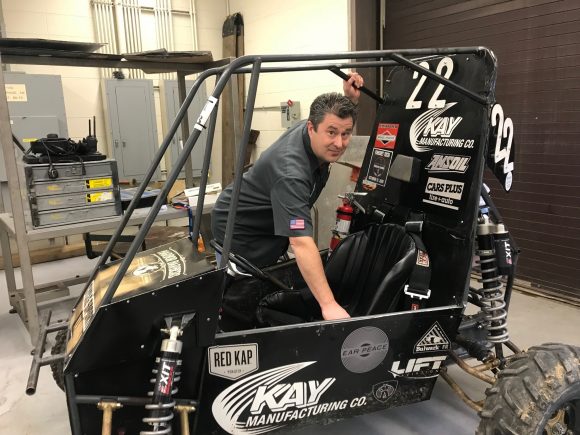Scroll down to listen to the podcast with Rick Rickerson.
Rick Rickerson is in charge of the machining lab at Purdue’s Northwest Indiana campus in Hammond. In today’s podcast he talks about why he loves his job. “It’s all about students” he says. His passion for teaching beams throughout the interview.
Rick has been doing this job for 14 years. His department has a half-dozen South Bend lathes (now made in Utah), but the students gravitate to the Haas VF-2 vertical machining centers.
The part of his duties that really gets the students’ juices going is the Purdue Northwest racing team. Every year students all over the country build a Baja-type racing buggy with the same Briggs and Stratton engine. They build it from scratch and are responsible for every nut, bolt and weld. Thousands of hours go into the preparation for two races in the spring presided over by SME judges. The preparation is strenuous, and the races are exhausting for the students and Rick, but he loves it. The judges grill the student builders and racers about the vehicles. Once they get on a track the buggies invariably break down, and the kids have to rebuild them on the spot. It’s a fantastic learning experience.
Question: Is building a Baja-type racing buggy from scratch a good way to learn machining?
Podcast: Play in new window | Download


5 Comments
Heck yes
We have been machining the rear drive hubs and wheel nuts for the University of Illinois for about 6 years now. Those engineering students and their shop classes teach something the standard curriculum doesn’t; How it all actually fits together and actually works, and how easy it is to be wrong in your design.
I haven’t seen a single hyperbolic paraboloid since Calc 4, but I remember perfectly clearly designing and building a rocket powered by a CO2 cartridge “ignited” by a sharpened set screw on a piece of spring steel. Darn near took out a co-student when the guidance was not substantial enough to overcome the tendency spin under thrust, regardless of how it all worked out on paper.
And the difference between machining aluminum, steel, and brass on a Bridgeport mill. Priceless.
No question they are learning something. I wish we had that big of a department to take on a project like that when I was in school.
Kudos to Rick Rickerson.
Yes – to your question:
Building a racing buggy from scratch IS a good way to learn machining as well as so many other associated disciplines.
We all know, or should know, you must crawl and walk be for you run!
Yes – we all want to play with the fancy (CNC) toys, but so many in the manufacturing industry lack foundational principles, many that are sometimes best learned in the school of hard knocks.
CNC/CAD is great and has its place but good ole’ conventional machining is often best for one off and small short run parts. As well as learning machining principals.
I learned how to sharpen a # 44 drill for buckets of stainless steel parts at the age of 9 years old.
You very quickly learn about speed, feed, cooling, lubrication, grind angles etc…
IMHO
Rarely is any foundation taught, regardless of subject.
Our youth cannot write, spell, form a cohesive sentence, perform mental math and are socially inept due to avoidance of personal interaction with their electronic devices.
“A human being should be able to change a diaper, plan an invasion, butcher a hog, conn a ship, design a building, write a sonnet, balance accounts, build a wall, set a bone, comfort the dying, take orders, give orders, cooperate, act alone, solve equations, analyze a new problem, pitch manure, program a computer, cook a tasty meal, fight efficiently, die gallantly. Specialization is for insects.”
― Robert A. Heinlein (author of Starship Troopers)
We need to go back to the curriculum of the Apprenticeship as out lined by The Federal Bureau of Apprenticeships. It built on a foundation of learning on manual machinery. After that learning CNC operation and programming was a walk in the park. But more than learning to operate manual machines was the training to use your head, common sense, understanding materials and processes, metallurgy, applying the mathematics, and most of all, problem solving.
Our best engineers from the 50s, 60s, and 70’s came out of tool and die apprenticeships.
What’s this about South Bend being made in Utah? I did a bit of poking around but couldn’t find any more info.